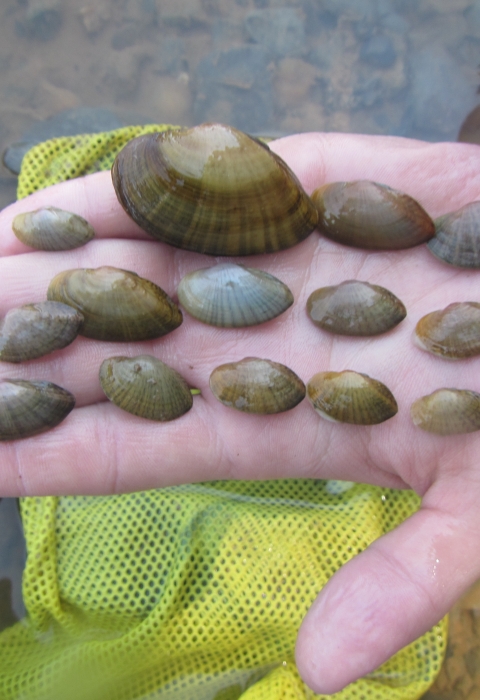Overview
This Texas-endemic freshwater mussel species occurs in the Colorado, Brazos and Trinity river basins of central Texas. Like many other freshwater mussels, the proposed threatened Texas fawnsfoot has a unique life cycle that requires the use of a host fish to transform the immature larva stage into a self-supporting juvenile mussel. What makes the Texas fawnsfoot even more unique is that the species is believed to utilize a self-sacrificing reproductive strategy when the females infests the molluscivore host fish with glochidia immediately before being ingested. The species is small in size with a compressed, elongate oval shell that is dull green, tan or yellow-brown with broken rays consisting of inverted chevrons, blotches or zig-zag patterns.
Scientific Name
Identification Numbers
Characteristics
Physical Characteristics
The shell is dull green, tan or yellow-brown with broken rays consisting of inverted chevrons, blotches or zig-zag patterns. The interior shell surface, nacre, is typically white, with an occasional salmon or yellow tint.
The Texas fawnsfoot is a small to medium-sized freshwater mussel with a compressed, elongated oval shell. The beaks are elevated above the hinge line with three to six fine, single hoop ridges that sometimes may include one to two heavier ridges. The shell disc lacks sculpturing and has a slightly angular posterior ridge. Pseudocardinal teeth, which are molar-like structures located near the beaks on the interior surface, are compressed and triangular. The lateral teeth, two in the left valve and one on the right, are relatively thin.
Measurements
Adult length: Maximum of approximately 2.5 in (60 mm)
Similar Species
Food
Like all other freshwater mussel species, Texas fawnsfoot are filter feeders that feed and survive on organic particulate matter, bacteria and algae that are filtered from the water column. Juvenile mussels live in the sediment and most likely feed interstitially rather than from the water column, using the relatively large muscular foot to sweep organic and inorganic particles found among the substrate into the shell opening.
Life Cycle
The Texas fawnsfoot, like all freshwater mussels, has an interesting life history. Males release sperm into the water column, which is taken in by the female fertilizing her eggs. The developing larvae are held by the female until they mature and are ready for release. The mature larvae, called glochidia, are released in proximity to a fish host and attach to the host’s gills or fins. It is believed that Texas fawnsfoot will frequently self-sacrifice and release mature glochidia immediately preceding being predated upon by the species host fish. Glochidia that fail to attach to a suitable host or attach to the wrong location will die. Attached glochidia encyst, or implant, into the host and develop into juvenile mussels over a period of weeks or months. Once fully developed, the juveniles excyst, or break away, from the host and settle on the stream bottom leaving their host relatively unharmed.
Texas fawnsfoot are considered to be long-term brooders, or bradytictic, and are assumed to use freshwater drum (Aplodinotus grunniens) as a host fish.
No age at maturity information exists for this species, but similar species like Truncilla spp. and tribe Lampsilini, have life spans from 8 to 18 years and 4 to 50 years, respectively.
Habitat
The Texas fawnsfoot is found in flowing, medium to large-sized streams with substrates of mud, sand and gravel and are often found in bank habitats or occasionally backwater, riffle and point bar habitats that may serve as flow refugia during high water events.
Geography
The Texas fawnsfoot is endemic to Texas and is known to occur in the Colorado, Brazos and Trinity river basins across 28 counties in Texas.
Timeline
Explore the information available for this taxon's timeline. You can select an event on the timeline to view more information, or cycle through the content available in the carousel below.
19 Items